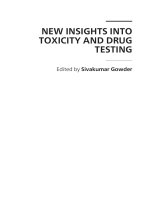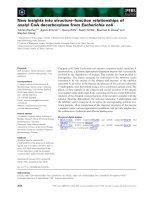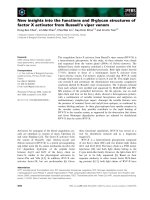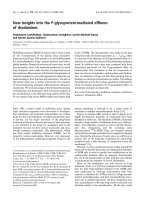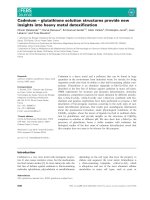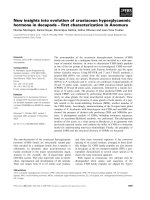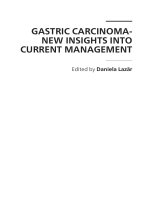NEW INSIGHTS INTO FIBROMYALGIA pot
Bạn đang xem bản rút gọn của tài liệu. Xem và tải ngay bản đầy đủ của tài liệu tại đây (7.9 MB, 232 trang )
NEW
INSIGHTS INTO
FIBROMYALGIA
Edited by William S. Wilke
New Insights into Fibromyalgia
Edited by William S. Wilke
Published by InTech
Janeza Trdine 9, 51000 Rijeka, Croatia
Copyright © 2011 InTech
All chapters are Open Access distributed under the Creative Commons Attribution 3.0
license, which allows users to download, copy and build upon published articles even for
commercial purposes, as long as the author and publisher are properly credited, which
ensures maximum dissemination and a wider impact of our publications. After this work
has been published by InTech, authors have the right to republish it, in whole or part, in
any publication of which they are the author, and to make other personal use of the
work. Any republication, referencing or personal use of the work must explicitly identify
the original source.
As for readers, this license allows users to download, copy and build upon published
chapters even for commercial purposes, as long as the author and publisher are properly
credited, which ensures maximum dissemination and a wider impact of our publications.
Notice
Statements and opinions expressed in the chapters are these of the individual contributors
and not necessarily those of the editors or publisher. No responsibility is accepted for the
accuracy of information contained in the published chapters. The publisher assumes no
responsibility for any damage or injury to persons or property arising out of the use of any
materials, instructions, methods or ideas contained in the book.
Publishing Process Manager Adriana Pecar
Technical Editor Teodora Smiljanic
Cover Designer InTech Design Team
Image Copyright Bartek Zyczynski, 2011. Used under license from Shutterstock.com
First published December, 2011
Printed in Croatia
A free online edition of this book is available at www.intechopen.com
Additional hard copies can be obtained from
New Insights into Fibromyalgia, Edited by William S. Wilke
p. cm.
ISBN 978-953-307-407-8
free online editions of InTech
Books and Journals can be found at
www.intechopen.com
Contents
Preface IX
Part 1 Pathogenesis of Fibromyalgia 1
Chapter 1 Sleep and Fibromyalgia 3
Fumiharu Togo, Akifumi Kishi and Benjamin H. Natelson
Chapter 2 Central Sensitization and
Descending Facilitation in Chronic Pain State 19
Emiko Senba, Keiichiro Okamoto and Hiroki Imbe
Chapter 3 Animal Models of Fibromyalgia 41
Yukinori Nagakura, Hiroyuki Ito and Yasuaki Shimizu
Chapter 4 Psychosocial Factors in Fibromyalgia:
A Qualitative Study on Life Stories and
Meanings of Living with Fibromyalgia 59
Paula J. Oliveira and Maria Emília Costa
Chapter 5 The Role of Oxidative Stress and Mitochondrial
Dysfunction in the Pathogenesis of Fibromyalgia 77
Mario D. Cordero, Manuel de Miguel
and José Antonio Sánchez Alcázar
Part 2 Definition and Diagnosis of Fibromyalgia 99
Chapter 6 The Affective-Motivational Domain of
the McGill Pain Questionnaire Discriminates
Between Two Distinct Fibromyalgia Patient Subgroups –
A Preliminary Study Based on Self-Organizing Maps 101
Monika Salgueiro and Jon Jatsu Azkue
Chapter 7 The Difficulties in Developing and
Implementing Fibromyalgia Guidelines 117
M. Reed and M. Herrmann
VI Contents
Chapter 8 Alexithymia in Fibromyalgia Syndrome 139
Ercan Madenci and Ozlem Altindag
Chapter 9 Diagnosis of Fibromyalgia Syndrome:
Potential Biomarkers and Proteomic Approach 149
Federica Ciregia, Camillo Giacomelli, Laura Giusti,
Antonio Lucacchini and Laura Bazzichi
Part 3 Treatment of Fibromyalgia 167
Chapter 10 Mind Body Therapies in the Rehabilitation Program
of Fibromyalgia Syndrome 169
Susanna Maddali Bongi and Angela Del Rosso
Chapter 11 Influence of Cognitive and Affective Variables
in Stress, Functional Limitation and
Symptoms in Fibromyalgia 187
Lilian Velasco, Cecilia Peñacoba, Margarita Cigarán,
Carmen Écija and Rafael Guerrero
Preface
I try, not always successfully, to read most of each week’s edition of The Economist. In
the October 15th-21st science section a report Transporter of Delight, discusses new
information about the genetic underpinning of happiness, and confirmed some of my
biases about the biopsychosocial nature of fibromyalgia. The story reported that Jan-
Emanuel De Neve and colleagues performed a rigorous case control study involving
1,939 adolescents (De Neve J-E et al, 2011). Genetic information was collected and
correlated with a validated satisfaction questionnaire. They controlled for other
important potentially causative factors including education, economic status,
religiosity, and many others, and discovered a gene that regulates happiness, the same
gene that is found in people with fibromyalgia. The magazine story is the genesis for
this polemic.
A little background
Human DNA is composed of approximately 21,000 genes, distinct regions arranged in
23 pairs - one each from the mother and father. The two components of each separate
gene have subtle differences of amino acid distribution, which affect their function.
These slightly different functional variants of the same gene are called alleles. The
gene of interest is called 5-HTTLPR and modulates serotonin concentrations in the
nervous system. This gene consists of a short and long allele, based on the number of
amino acid residues in their structures - the long one produces more serotonin
transporter proteins, which produce more serotonin than the shorter allele.
The researchers found that individuals with long alleles and those with higher
serotonin concentrations in the nervous system were statistically more likely to be very
satisfied with their life, compared to individuals with short alleles (p=0.012).
Serotonin is a chemical, which is released by neurons and governs the magnitude of
neural activity. Low serotonin concentrations in the central nervous system is causally
linked to affective disorders (Thieme K et al, 2004; Abeles AM et al, 2007). This same
alteration of the serotonergic system is a crucial factor underlying the severity and
pathogenesis of FMS (Russell IJ et al 1992; Stahl SM et al, 2009).
Familial aggregation occurs in fibromyalgia. For example, among 533 first degree
relatives of 78 fibromyalgia patients compared to 272 first degree relatives of 40
X Preface
rheumatoid arthritis patients, the odds ratio for having fibromyalgia was 8.5 in
fibromyalgia relatives versus the rheumatoid arthritis relatives (Arnold LM et al,
2004). Others have demonstrated an increased frequency of the short allele of the
serotonin transporter gene 5-HTTLPR in fibromyalgia (Offenbacher M et al, 1999). In
the general population, the short allele confers vulnerability to a spectrum of illnesses
including anxiety disorder, depression, and bipolar disorder (Lucki I, 1998).
Furthermore, increased amygdala activation to environmental stresses such as facial
expression, proven by functional magnetic resonance imaging (Hariri AR et al, 2006),
and other methods (Munafo MR et al, 2008) has been linked to this same allele. The
amygdala is responsible for negative interpretation of environmental stimuli;
increased activation equals higher “fear factor”.
Next piece, temperament
In 1993, C. Robert Cloninger postulated that temperament, which can be best
understood as automatic emotional responses to situations in society by an individual,
might be primarily due to inheritance (Cloninger CR et al, 1993). He constructed a
model of four descriptive personality dimensions, which included novelty seeking,
harm avoidance, reward dependency and persistence. People with harm avoidance
were described as having “ pessimistic worry in anticipation of future problems,
fear of uncertainty, shyness of strangers and rapid fatigability.” Those with novelty
seeking were curious, disorganized, quick-tempered and impulsive. Reward
dependence traits include sensitivity and a need for societal contact. Not surprisingly,
people with the persistence trait were described as industrious and hard working. He
suggested that all of our personalities are a mixture of these traits, and in some
individuals, one or another trait dominates.
He further predicted that each of these traits was due to different genes which were
intimately related to brain chemistry metabolism. Harm avoidance was related to
serotonin pathways, novelty seeking to dopamine pathways, and the last two to
norepinephrine pathways. Research since 1992 has shown that these relationships are
a bit more complicated, but the general concept is largely confirmed. Of significance, a
recent publication has shown a higher frequency of both the short 5-HTTLPR allele
and harm avoidance temperament trait in patients with fibromyalgia compared to
controls (Cohan H et al, 2002).
The genetic plus side
At this point, I have associated unhappiness, 5-HTTPR short allele, harm avoidance
due to amygdala activation, low central nervous system serotonin with fibromyalgia.
This relationship makes sense. In the medical and in psychology and economic
literature, people with harm avoidance are prone to increased situational fear
responses, depression, and low self direction, as well as fibromyalgia (Celikel FC et al,
2009; Glazer Y et al, 2010). However, they are also more likely to be creative, more
spiritual, more likely to participate in the arts (Bachner-Melman R et al, 2005), and
Preface XI
perform better academically (Calapoglu M et al, 2011). In my own clinic, patients with
FMS tell me that they always lock their doors, have insurance, pay their bills on time,
wear their seat belts and vote regularly. They are good, careful people, people with
high harm avoidance. The long allele is not associated with harm avoidance-they are
happy, but not necessarily very careful people. They take chances.
Our first attempts at literature were epic poems that celebrated heroes. These were
people like Beowulf, who went off into the dark woods to slay the monster Grendel, and
Odysseus, who sailed off beyond the sight of land to great adventure. Why were these
people celebrated? Because they came back. Most people who entered the great woods
alone or sailed beyond the sight of land never returned. Who were these people?
Certainly not the ones with high harm avoidance traits. The harm avoidance people
stayed home and procreated. This was a good trait. They were a bit afraid, but they
weren’t stupid. They planned ahead, put up stocks and were ready for winter. They
brought order and law to society. What’s more, in times of societal stress, they slept
lightly and gave the first alarms. With their enhanced central sensitivity, they were the
first to hear the enemy, to perceive signs of the attacker in the woods, to smell the
hunting animal’s approach. It mattered little to the genes how these harm avoiders felt
during times of stress. All that was important was getting through the danger safely.
Anyway, most of those ancient stressful events resolved quickly and were short-lived.
For most of our history, having these genes was predominantly a good thing.
Societal prospective
If we consider the evolution of our species during the last 100,000 years, we live in
very special, very different times. We no longer respect diurnal variation, the dictates
of the sun and moon. We have efficient artificial lighting. We’re shift workers with
little respect for sleep. Unprecedented sensory input from radio, television, PCs, iPods,
Blackberries, cell phones, and beepers allow no down time and facilitates “multi-
tasking” as never before. We’re told by advertisers that we need more and more of
these things so that we can watch Reality Shows which demean contestants as a
substitute for entertainment, tune in to news shows which compete under the mantra,
“If it bleeds, it leads”, and experience the negative radio and television sound bites for
politicians who will protect us from the terrorists who, incidentally, are everywhere
(Hassett AL et al, 2002). We, especially in the United States, are stressed and in trouble.
Expenditures for health care per capita in the United Kingdom are less than half the
monies spent in the United States ($2164 versus $5274 ), but people in the United
States are relatively less healthy according to Banks and colleagues (Banks J et al,
2006). They analyzed self-reported illness profiles completed by approximately 10,000
US residents and approximately 5,500 UK residents all middle-aged or older, and
discovered that the usual risk factors for diabetes, atherosclerotic heart and vascular
disease, which include traditional definitions of lower socioeconomic status, obesity,
tobacco, and alcohol use, did not fully explain these differences. From the same study,
we also learned that C- reactive protein (CRP), which is also associated with the risk of
XII Preface
heart and vascular disease (Ridker PM et al, 2002), was 20 percent higher in US
residents, and also not explained by those previously mentioned traditional disease
risk factors. They concluded that there must be some other important risk factor(s).
In Banks’ discussion, we are reminded that psycho-social factors (also known as stress)
play a major role in conferring poorer health for people in lower socio-economic
stratas of society. Lower social status has been shown to increase the risk of the
Metabolic Syndrome (Wannamethee SG et al, 2007), which is at the root of diabetes
and cardiovascular disease. In addition, the serum level of CRP rises as socio-
economic status falls (Steptoe A et al, 2003). Banks points out that we are progressively
losing our middle class in the US (Banks J et al, 2006). This places more and more of us,
if not in the traditional lower class, but still at accelerating “socio-economic risk”.
Therefore, increasing stress, an important cause of FMS, and which increases as social
status declines, also mediates elevation of CRP, which is at the very least a surrogate
measure of declining overall health.
One valid interpretation of Banks’ important report is that people who live in the US
experience greater stress than do people who live in the UK, hence the higher CRP,
and that stress makes people in the US less healthy than their UK counterparts - US
residents, therefore, live in a stressful and not very healthy society. The concept that
origins of most diseases are at least in part due to social inequities and mood/affective
disorders is still novel for most physicians, but hardly a new or unique interpretation
(Syme SL et al, 1976; Moussavi S et al 2007). Moreover, certain illness profiles might
preferentially manifest in the genetically susceptible.
Genes determine magnitude of response to stress, susceptibility to depression, and are
a major determinant of who manifests fibromyalgia and who doesn’t (Martinez-Lavin
M et al, 2007; Caspi A et al, 2003).
As we already know, genetic background dictates susceptibility to depression, and the
short allele contributes (Munafo MR et al, 2006)). When distress begets depression, it
gradually reduces health scores (Moussavi S et al, 2007), accelerates atherosclerosis
(Faramawi MF et al, 2007), and by shortening telomeres, may contribute to premature
cellular senescence (Simon NM et al, 2006). Stress also raises markers of inflammation
and is an important player in the pathogenesis of FMS (Chandola T et al, 2006; Abales
AM et al, 2007).
An analysis by Wolfe and co-workers might help us to understand this better (Wolfe F et
al, 2006). In Wolfe’s “Survey Criteria”, used to diagnose fibromyalgia, if numerical
values are given to two symptoms, pain and fatigue, and the values added, a numerical
Symptom Intensity Scale is produced. When this scale was applied to 25,417 patients in
his data base, regardless of the presence or absence of fibromyalgia, higher scores on the
scale were associated with more severe medical illnesses of all kinds, greater mortality,
and more socioeconomic disadvantage. So, having cardinal symptoms of stress, pain,
and fatigue, often a surrogate for depression, is clearly associated with poor health.
Preface XIII
Furthermore, this study allows us to generalize the concept to the entire population, a
population in which as we are told by economists, the middle class is shrinking. We’re
all getting increasingly stressed, our moods worsened, and some of us manifest this
situation as the symptoms of pain and fatigue. Add a new study, which shows that
negative mood mediates sleep abnormalities in people with chronic pain, and the
conceptual illness fibromyalgia is complete (O’Brien EM et al, 2010).
Canaries
Who are the first people, the early warning system, who notice this toxic
environmental state of affairs? The harm avoiders of course, and with their sensitive
serotonin genes, they experience it viscerally, with symptoms. People with
fibromyalgia, genetically determined neurologic central sensitivity, have real
physiologic symptoms, which constitute illness by definition when they seek medical
care. The pathogenesis of their symptoms is multifactorial and includes chronic
distress/stress from living in a society that would have been described as a dystopia in
1950’s science fiction literature.
Genes interacting with society; no wonder it’s so hard to treat fibromyalgia. These
sensitive, relatively unhappy people whose fear nerves fire at lower thresholds, are the
canaries in our society’s coal mine. Canaries first. Eventually, we are all at risk.
Back to the book
This discussion is a polemic, a persuasion and a hypothesis about how the various
pieces fit and interact in the puzzle that is fibromyalgia, and reduced to the most
fundamental, happiness and society. Since we’re ultimately dealing with science, it is
one approximation of “the truth”. This book provides further pieces to the puzzle.
We’ll keep trying to get it right.
Dr. William S. Wilke, M.D.
Department of Rheumatic and Immunologic Diseases,
A50 Cleveland Clinic, Orthopedic and Rheumatologic Institute,
Cleveland, Ohio,
USA
References
Abales AM, Pillinger MH, Soltar BM, Abeles M: Narrative review: The
pathophysiology of fibromyalgia. Ann Intern Med 2007; 146; 726-734
Arnold LM, Hudson JI, Hess EV et al: Family study of fibromyalgia. Arthritis Rheum
2004; 50: 944-952
Bachner-Melman R, Dina C, Zohar AH: AVPR1a and SLC6A4 gene polymorphisms
are associated with creative dance performance. PLOS Genetics 2005; 1: 0394-
0403
XIV Preface
Banks J, Marmot M, Oldfield Z, Smith JP: Disease and disadvantage in the United
States and in England. JAMA 2006; 295: 2037-2045
Calapoglu M, Sahin-Calapoglu N, Karacop A et al: Serotonin transporter bi- and
triallelic genotypes and their relationship with anxiety and academic
performance: a preliminary study. Neuropsychobiology 2011; 63: 103-111
Caspi A, Sugden K, Moffit TE et al: Influence of life stresses on depression: Moderation
of a polymorphism of the 5-HTT gene. Science 2003; 301: 386-389
Celikel FC, Kose S, Cumurcu BE, et al: Cloninger’s temperament and character
dimensions of personality I patients with major depressive disorder. Comp
Psyciatry 2009; 50: 556-561
Chandola T, Brunner E, Marmot M: Chronic stress at work and the metabolic
syndrome: prospective study. BMJ 2006; 332: 521-525
Cloninger CR, Svakic DM, Przybeck TR: A psychobiological model of temperament
and character. Arch Gen Psychiatry 1993; 50: 975-990
Cohan H, Buskila D, NeumannL, et al: Confirmation of an association between
fibromyalgia and serotonin transporter promoter region (5-HTTLPR)
polymorphism and relationship to anxiety-related personality traits. Arthritis
Rheum 2002; 46: 845-847
De Neve J-E, Christakis N A, Fowler JH, Frey B S: Genes, economics, and happiness:
GenesEconomicsHappiness_RESTAT_20sept11.tex date: September 20, 2011
Faramawi MF, Gustat J, Wildman RP, et al: Relationship between depressive
symptoms and common carotid artery atherosclerosis in american persons
=/>65 years of age. Am J Cardiology 2007; 99: 1610-1613
Glazer Y, Buskila D, Cohen H, et al:Differences in personality profile of fibromyalgia
patients and their relatives with and without fibromyalgia. Clin Exp
Rheumatol 2010; 28 (Suppl): S27-S32
Hariri AR, Drabant EM, Weinberger DR: Imaging genetics: Perspectives from studies
from genetically driven variation in serotonin function and corticolimbic
affective processing. Biol Psychiatry 2006; 59: 888-897
Hassett AL, Sigal LH: Unforeseen consequences of terrorism. Medically unexplained
symptoms in a time of fear. Arch Intern Med. 2002; 162:1809-1813
Lucki I: The spectrum of behaviors influenced by serotonin. Biol Psychiatry 1998; 44:
151-162
Martinez-Lavin M: Stress, the stress response and fibromyalgia. Arthritis Res Therapy
2007; 9: 216-223
Moussavi S, Chatterji S, Verdes E, et al: Depression, chronic diseases, and decrements
in health: Results from the World Health Surveys. Lancet 2007; 370: 851-858
Munafo MR, Brown SM, Hariri AR: Serotonin transporter (5-HTTLPR) genotype and
amygdala activation: A meta-analysis. Biologic Psych 2008; 63: 852-857
Munafo MR, Clark TG, Roberts KH, Johnstone EC: Neuroticism mediates the
association of serotonin transporter gene with lifetime major depression.
Neuropsychobiology 2006; 53: 1-8
O’Brien EM, Waxenberg LB, Atchison JW et al: Negative mood mediates the effect of
poor sleep on pain among chronic pain patients. Clin J Pain 2010; 26: 310-319
Preface XV
Offenbacher M, Bondy B, de Jong S, et al: Possible association of fibromyalgia with a
polymorphism in the serotonin transporter promoter regulatory region.
Arthritis Rheum 1999; 42: 2482-2488
Ridker PM, Rifai N, Rose L, et al: Comparison of c-reactive protein and low-density
lipoprotein cholesterol level in the prediction of first cardiovascular events. N
Engl J Med 2002; 347: 1557-1565
Russell IJ, Vaeroy H, Javors M, et al: Cerebrospinal fluid biogenic amine metabolites in
fibromyalgia/fibrositis syndrome and rheumatoid arthritis. Arthritis Rheum
1992; 35: 550-556
Simon NM, Smoller JW, McNamara KL, et al: Telomere shortening and mood
disorders: Preliminary support for a chronic stress model of accelerated
aging. Biol Psychiatry 2006; 60: 432-435
Stahl SM: Fibromyalgia-pathways and transmitters. Human Psychopharmacol 2009;
24: S11-S17
Steptoe A, Kunz-Ebrecht S, Owen N, et al: Influence of socioeconomic status and job
control on plasma fibrinogen responses to acute mental stress. Psychosom
Med 2003; 65: 137-144
Syme SL, Berkman LF: Social class, susceptibility, and sickness. Am J Epidemiol 1976;
104: 1-8
Thieme K, Turk DC, Flor H: Comorbid depression and anxiety in fibromyalgia
syndrome: Relationship to somatic and psychosocial variables.
Psychosomatic Medicine 2004; 66: 837-844
Wannamethee SG, Whincup PH, Rumley A, Lowe GDO: Inter-relationships of
interleukin-6, cardiovascular risk factors and the metabolic syndrome among
older men. J Thromb Haemost 2007; 5: 1637-1643
Watanabi MAE, Nunes SOV, Amarante MK et al: Genetic polymorphism of serotonin
transporter 5-HTTLPR: involvement in smoking behavior. J Genetics 2011;
90:179-185
Wolfe F, Rasker JJ: The Symptom Intensity Scale, fibromyalgia, and the meaning of
fibromyalgia-like symptoms. J Rheumatol 2006; 33: 2291-2299
Part 1
Pathogenesis of Fibromyalgia
1
Sleep and Fibromyalgia
Fumiharu Togo
1
, Akifumi Kishi
2
and Benjamin H. Natelson
3
1
Educational Physiology Laboratory, Graduate School of Education,
The University of Tokyo, Tokyo,
2
Division of Pulmonary, Critical Care and Sleep Medicine, Department of Medicine,
NYU School of Medicine, New York, NY,
3
Pain and Fatigue Study Center, Beth Israel Medical Center,
Albert Einstein Medical Center, New York, NY,
1
Japan
2,3
USA
1. Introduction
Fibromyalgia (FM) is a medically unexplained illness characterized by four quadrant pain
lasting at least 3 months and accompanied by multiple areas of tenderness on palpation of
the body using 4 kg force. FM occurs more often in women than men but is quite common in
both sexes, occurring in approximately 3% of the population. Although sleep difficulties are
not part of standard diagnostic criteria, insomnia complaints of poor and nonrestorative
sleep are common and have been associated with intense of pain, fatigue, sleepiness, and
cognitive difficulties in FM.
FM frequently occurs in conjunction with chronic fatigue syndrome (CFS). CFS is a
medically unexplained condition characterized by persistent or relapsing fatigue lasting at
least 6 months, which substantially reduces normal activity. In addition to severe fatigue,
one of the eight symptoms used for diagnosing CFS is “unrefreshing sleep”, and this sleep-
related problem is the most common complaint among CFS patients.
Although, FM and CFS often have similar symptoms, including sleep-related complaints,
differences between FM and CFS exist. In this chapter, we will review studies on sleep in
FM and CFS patients in order to better understand differences between them.
Polysomnographic studies have shown sleep problems in FM by using simple descriptive
statistics, for instance, increased non-rapid eye movement (non-REM) Stage 1 sleep, reduced
slow-wave (Stages 3 and 4) sleep, more arousals, prolonged sleep onset, reduced sleep
efficiency, etc. Sleep problems in CFS shown by polysomnographic studies are quite similar
to those in FM. However, we have shown that dynamic aspects of sleep, a new way of
assessing sleep, are different between patients with CFS alone compared to those with
CFS+FM. The probability of transition from rapid eye movement (REM) sleep to waking in
CFS is greater than in healthy controls. Probabilities of transitions from waking, Stage 1
sleep, and REM sleep to Stage 2 and those from slow-wave sleep to waking and Stage 1
sleep are greater in FM+CFS than in healthy controls.
Over the course of the many decades, sleep researchers have used simple descriptive
statistics to characterize and summarize sleep architecture. While this methodology has
New Insights into Fibromyalgia
4
been extremely useful in defining the abnormalities that currently constitute sleep
pathology, this approach does not explain specific patient complaints of disturbed and
unrefreshing sleep. However, a dynamic analysis complements the classical approach by
allowing an analysis of transition dynamics between sleep stages and shows that FM and
CFS may be different illnesses associated with different problems in sleep regulation.
2. Sleep studies and FM
2.1 Sleep and symptoms of FM
Although sleep difficulties are not part of standard diagnostic criteria (Wolfe et al., 1990),
insomnia complaints of poor and nonrestorative sleep are common in patients with FM. An
early study shows that 65.7% of patients with FM reported nonrestorative sleep (White et
al., 1999). Recently, two epidemiologic studies (Bigatti et al., 2008; Theadom et al., 2007)
reported that more than 90% of patients with FM complain about sleep problems such as
difficulty falling asleep, difficulty falling back to sleep after waking up during nocturnal
sleep, and unrefreshing sleep. Sleep is also one of the domains which associate most
strongly with the patients’ overall impression of improvement (Arnold et al., 2011).
Data strongly suggest that FM-like symptoms develop following sleep disruption in healthy
volunteers. Four studies in normal healthy controls (Lentz et al., 1999; Moldofsky et al.,
1975; Moldofsky & Scarisbrick, 1976; Onen et al., 2001) have reported increases in
musculoskeletal pain and/or decreases in pain threshold after a period of sleep disruption
or deprivation, while one study did not find this result (Older et al., 1998). Moldofsky’s
group found that Stage 4 sleep deprivation was associated with increasing in tenderness,
musculoskeletal symptoms, and mood disturbances (Moldofsky et al., 1975; Moldofsky &
Scarisbrick, 1976). In addition, healthy volunteers with disrupted sleep produced
experimentally by sound pulses every 2 minutes but with normal total sleep time had a
decrease in day-time energy levels. Moreover, their ability to do complex auditory
monitoring tasks was also impaired (Martin et al., 1996). These data indicate that partial
sleep deprivation can produce the hallmark symptoms of FM – namely, musculoskeletal
achiness, marked daytime fatigue, and cognitive problems.
One study reported that sleep disturbances led to exacerbation of pain in patients with FM
(Affleck et al., 1996). One recent study reported that negative mood (i.e., depression and
anxiety), which are common among chronic pain patients or poor sleepers, almost fully
mediated the relationship between sleep and pain in chronic pain patients (O'Brien et al.,
2010). Moderating impact of depressive symptoms on the relationship between sleep and
pain was also reported in another study (O'Brien et al., 2011).
2.2 Sleep disorders in patients with FM
One group suggested that as many as 33% of individuals with FM had the restless leg
syndrome (Viola-Saltzman et al., 2010). Another recent study (Gold et
al., 2004) reported a
high rate of sleep disturbed breathing in patients with FM (i.e., 96%). The prevalence of
overweight women (Moldofsky, 2002) may contribute to sleep disturbed breathing, such as
sleep apnea and inspiratory airflow limitation with arousals (Gold et al., 2004). However,
one study found that patients with FM had the same frequency of sleep apnea as normal
controls (Molony et al., 1986). Unpublished data from our laboratory finds rates of FM in
patients with polysomnography-documented obstructive sleep apnea to be similar to those
Sleep and Fibromyalgia
5
found in the community. A genetic study found common genetic characteristics between
FM and narcolepsy (Spitzer & Broadman, 2010).
2.3 Sleep abnormality in patients with FM
In contrast to studies on sleep pathology, a host of studies strongly suggest that the pattern
of sleep is abnormal in many FM patients. The most consistent abnormality is significantly
increased Stage 1 sleep compared to healthy controls (Anch et al., 1991; Cote & Moldofsky,
1997; Drewes et al., 1994; Landis et al., 2004; Leventhal et al., 1995; Molony et al., 1986;
Shaver et al., 1997). Sleep disturbance in patients with FM is obvious because
polysomnographic studies have shown longer sleep latencies (Drewes et al., 1994; Horne &
Shackell, 1991; Landis et al., 2004), more wakefulness (Drewes et al., 1994), reduced sleep
efficiency (i.e., the proportion of time spent sleeping relative to the time available for
sleeping) (Drewes et al., 1994; Landis et al., 2004), reduced Stage 2 sleep (Landis et al.,
2004), and reduced Stage 4 sleep (Anch et al., 1991; Lashley, 2003) in FM patients compared
to healthy control subjects of similar age. Patients with FM awaken more easily (Perlis et al.,
1997) and compared to healthy controls have higher levels of physical activity during the
night (Affleck et al., 1996; Korszun et al., 2002).
Although sleep efficiency was comparable to that of controls, FM patients showed more
arousals (Jennum et al., 1993; Molony et al., 1986) and Stage 1 sleep (Molony et al., 1986).
Molony et al. reported that patients with FM had three times more microarousals (brief sleep
interruptions lasting 5-19 seconds) per hour than did healthy controls (Molony et al., 1986).
These results indicate that patients with FM have poor sleep quality with fragmented sleep.
An alpha-EEG anomaly during non-REM sleep has been considered a biologic correlate of
chronic pain and a possible basis of nonrestorative sleep complains in patients with FM
(Branco et al., 1994; Moldofsky et al., 1975; Moldofsky & Scarisbrick, 1976; Moldofsky, 1989;
Roizenblatt et al., 2001). The alpha-EEG anomaly is excessive alpha wave intrusion which
has been interpreted as a heightened arousal state during non-REM sleep (Moldofsky, 1989;
Scheuler et al., 1983). However, this has not been found consistently across studies (Horne &
Shackell, 1991). Alpha-delta sleep is an abnormal sleep EEG rhythm characterized by alpha
activity that is superimposed on delta waves of Stages 3 and 4 sleep (McNamara, 1993).
Horne and Shackell found that the mean alpha activity in Stages 2, 3, and 4 sleep were
greater for the patients with FM than in healthy controls (Horne & Shackell, 1991). Branco et
al. studied alpha and delta activity and the alpha-delta ratio across sleep cycles in patients
with FM and healthy controls (Branco et al., 1994). The alpha-delta sleep anomaly occurred
in almost all patients who had fragmented sleep; this anomaly was not observed in any of
the healthy controls. Perlis et al. found that the alpha-EEG sleep associated with perception
of shallow sleep and an increased tendency to display arousal in response to external
auditory stimuli (Perlis et al., 1997).
Most studies on alpha-EEG anomaly in patients with FM have been based on visual and hence
relatively subjective analysis of the EEG. Using spectral analysis, a quantitative measurement
is provided not only for alpha component of EEG, but also for other existing frequency
components. Drewes et al. examined spectral EEG patterns and found that patients with FM
showed more power in the alpha (higher frequency) band and a decrease in the lower
frequency bands in Stages 2, 3, and 4 sleep and all sleep cycles (Drewes et al., 1995). However,
the alpha-EEG anomaly is not specific for patients with FM in that it also occurs in healthy
individuals (Horne & Shackell, 1991; Scheuler et al., 1983; Shaver et al., 1997) and in patients
with disorders such as rheumatoid arthritis and CFS (Moldofsky et al., 1983; 1988).
New Insights into Fibromyalgia
6
A task force of the American Sleep Disorders Association has defined a cortical arousal
(American Sleep Disorders Association, 1992) as a return to alpha or fast frequency EEG
activity, well differentiated from the background, lasting at least 3 seconds. Cortical
microarousals are briefer arousals lasting at least 1.5 seconds (Martin et al., 1997). While the
major focus of sleep researchers studying arousals has been on EEG measures, one group
(Pitson & Stradling, 1998) suggested that non-EEG markers might be an important and even
more reliable sign of arousals than cortical arousal as reflected by the EEG. For example, it is
known that somatosensory and auditory stimulation during sleep can produce alterations in
cardiac, respiratory, and somatic measures without overt EEG desynchronization (Carley et
al., 1997; Halasz, 1993; Winkelman, 1999). These changes are thought to reflect activation of
the brainstem or subcortical arousal system without affecting the cortex. Hence current
thinking is that there are different levels of arousal responses generated from subcortical
and cortical areas of the brain (Sforza et al., 2000, 2002).
One study (Sforza et al., 2000) showed that bursts of K-complexes and delta waves,
expressions of an activation of subcortical arousal system, represent a real arousal response
inducing cardiac activation similar to that found during cortical arousals (microarousal and
phases of transitory activity). We have investigated sleep microstructure in young healthy men
with no sleep complaints (Togo et al., 2006). We found increases in delta wave power in both
cortical and subcortical arousals relative to just before the onset of the arousals; increases in
delta power might be an even better measure of arousals than alpha wave changes.
Symptoms of unrefreshing sleep are reported to be greater when the cyclic alternating
pattern (CAP, periodic appearance of delta waves and K-complexes) of EEG occupies a
greater percent of sleep (Terzano & Parrino, 2000). Sforza et al. suggested that bursts of delta
waves and K-complexes were expressions of subcortical arousals representing a real arousal
response with tachycardia similar to that seen during cortical arousals (Sforza et al., 2000).
Patients with FM have increased amounts of CAP – more so in the more severely
symptomatic patients (Rizzi et al., 2004).
3. Sleep studies and CFS
3.1 Sleep disorders in patients with CFS
One of the symptoms used for diagnosing CFS is unrefreshing sleep, and, in fact, this sleep-
related problem is the most common complaint among patients with severe medically
unexplained fatigue (Unger et al., 2004). Partial sleep deprivation in healthy people can
produce marked daytime fatigue (Martin et al., 1996), cognitive problems (Martin et al.,
1996), and musculoskeletal achiness (Lentz et al., 1999; Moldofsky & Scarisbrick, 1976; Onen
et al., 2001), which are the hallmark symptoms of CFS.
Several early studies suggested that as many as one-half of individuals with CFS have mild
sleep apnea syndrome (five or more episodes per hour of apnea/hypopnea), periodic leg
movements, or the restless leg syndrome (Buchwald et al., 1994; Krupp et al., 1993). Other
studies with more stringent criteria for these disorders either did not find this result (Krupp
et al., 1993; Le Bon et al., 2000; Sharpley et al., 1997; Togo et al., 2008).
3.2 Sleep abnormality in patients with CFS
Polysomnographic studies suggest that the sleep architecture is abnormal in CFS patients.
The most consistent abnormality is significantly reduced sleep efficiency when compared to
controls (Fischler et al., 1997; Krupp et al., 1993; Morriss et al., 1993; Sharpley et al., 1997);
Sleep and Fibromyalgia
7
the reported average values range from clearly abnormal (i.e., 76.5%) (Fischler et al., 1997) to
those within the normal range (i.e., 90%) (Morriss et al., 1993). From one study providing
data on individual patients’ sleep efficiencies, one can estimate that 75% of CFS patients
have reduced sleep efficiences (Krupp et al., 1993). Sleep disturbance in these patients is
obvious because they often show increases in time needed to fall asleep (Morriss et al., 1993;
Sharpley et al., 1997) and multiple periods of awakenings or arousals (Fischler et al., 1997;
Morriss et al., 1993; Sharpley et al., 1997). Decrease in total duration of Stage 4 sleep has also
been reported (Fischler et al., 1997).
We have recently reported the sleep architecture of a sample of female CFS patients during a
fixed period of their menstrual cycle and after excluding patients with diagnosable sleep
disorders and co-existing major depressive disorder to reduce patient pool heterogeneity
(Togo et al., 2008). These patients differed significantly from matched controls in showing
evidence of sleep disruption in the form of significantly reduced total sleep time, reduced
sleep efficiency, and shorter bouts of sleep than healthy controls. In comparison with
controls, sleep in CFS had little effect on either self-reported sleepiness or fatigue. And,
interestingly, for patients only, ratings of sleepiness and fatigue correlated well with total
sleep duration and efficiency. Dichotomizing the patients into a group that felt sleepier after
a night's sleep than before sleep [a.m. sleepier] and a group that felt less sleepy after a
night's sleep [a.m. less sleepy] reduced the variability of the sleep records considerably
(Togo et al., 2008).
Those patients reporting less sleepiness after a night's sleep had sleep structures similar to
those for healthy controls except for a shorter total sleep time and a commensurate
reduction in Stage 2 sleep; moreover, they reported their fatigue and pain to diminish
following sleep. In contrast, patients in the a.m. sleepier group had the greatest
abnormalities of sleep architecture, including poor sleep efficiency, longer sleep latency, and
more disrupted sleep as manifested by a higher percentage of short-duration sleep runs,
than either controls or patients in the a.m. less sleepy group.
As the time since awakening from sleep increases, sleep latency decreases (Devoto et
al.,
1999), and one early study of young adults reported an average sleep latency of 30 seconds
after a night of sleep deprivation (Carskadon & Dement, 1979). We have determined latency
to fall asleep for patients with CFS and healthy controls, previously habituated to sleeping
in a sleep lab, after such a night of sleep deprivation in our laboratory (Nakamura et al.,
2010). Nine healthy subjects fell asleep within 5 minutes, however 3 subjects took longer –
falling asleep within 9 minutes. The CFS patients as a group showed a significantly longer
latency to fall asleep after sleep deprivation, but the study population fell out into two
groups with the largest group of 10 patients falling asleep within 5 minutes. However, the
remaining 5 patients remained awake for a longer period than any control, suggesting that
they may have a disorder of arousal. Sleep latency following sleep deprivation correlated
inversely with sleep efficiency on the normal sleep night for the patients with CFS. Our
results indicate that some CFS patients may have a disorder of arousal which interferes with
normal sleep and may, at least in part, be responsible for their disabling fatigue.
3.3 Exercise and sleep in patients with CFS
Exercise elevates core body temperature and increases total duration of slow-wave sleep in
the night following exercise in healthy people (Horne & Staff, 1983). To our knowledge, only
our study (Togo et al., 2010) has compared sleep in CFS patients before and after exercise.
New Insights into Fibromyalgia
8
Exertion is a particularly interesting thing to study in CFS because a disabling and
characteristic feature of CFS patients is that even minimal exertion produces a dramatic
worsening of symptoms (Komaroff & Buchwald, 1991). No such effect occurs in healthy
controls and, in fact, some reports, although anecdotal, suggest that acute exercise can
actually improve sleep (Youngstedt et al., 1997).
We have used a standard cardiac-type stress test to probe effects of exertion on symptoms in
CFS patients in other studies too. First we found that CFS patients reported more fatigue as
much as four days after the exercise stress test (Sisto et al., 1996). Next, we used actigraphy
to monitor activity before and after exercise and found that activity levels also fell significantly
four days after the exercise stress test (Sisto et al., 1998). We recently replicated and extended
this finding using real-time assessment techniques and demonstrated that CFS symptoms do
worsen several days after maximal exercise but that neither mood nor cognitive function was
affected (Yoshiuchi et al., 2007). We interpreted these changes in activity to support the patient
complaint of worsening of symptoms induced by exercise or effort.
We recently investigated the influence of an acute bout of exercise on polysomnography and
self-reported measures of sleep (Togo et al., 2010). CFS patients as a group have disrupted
sleep characterized by significantly poorer quality sleep than controls. However, the
patients as a group showed evidence of improved sleep after exercise. The results were
clearer after we used the same stratification strategy that we had used in our earlier work
(Togo et al., 2008), that is, splitting subjects into those who were either sleepier or less sleepy
after a night’s sleep. As expected, exercise improved the sleep quality of healthy controls
who had reported decreased morning sleepiness after the baseline sleep night. Contrary to
expectation, it had the same result in CFS patients with decreased morning sleepiness.
However, patients who reported increased morning sleepiness showed no improvement in
sleep disruption, but exercise did not exacerbate their sleep pathology. These patients also
had the lowest average sleep efficiency of any of the groups studied. Because exercise did
not produce a significant worsening of sleep morphology in CFS, the complaints of
symptom worsening, which are reported to occur the next day after exertion, cannot be
explained by disruption in sleep. After exercise, approximately half the patients actually
sleep better than on their baseline study night, whereas the rest simply did not improve.
4. Sleep dynamics
4.1 Sleep dynamics in healthy humans
Most sleep studies have been performed based upon sleep stage scoring according to the
traditional standardized criteria established by Rechtschaffen and Kales (Rechtstchaffen &
Kales, 1968). While this methodology has been extremely useful to describe sleep
architecture, sleep stage analysis has been limited to simple descriptive statistics, such as
total sleep time, sleep efficiency, the number of awakenings, latencies to sleep onset and
REM sleep, and the total duration of each sleep stage.
Recently, sleep dynamics, such as transition probabilities among sleep stages and duration
distributions of each sleep stage, has been reported by some studies in which the importance
of dynamical aspects of sleep has been pointed out (Comte et al., 2006; Kishi et al., 2008, in
press; Lo et al., 2002). Yassouridis et al. (Yassouridis et al., 1999) studied survival time
statistics of a particular sleep stage ended by other different sleep stages with their event
history analysis, a modification of the Cox regression analysis of life-tables (Cox, 1972), by
assuming an exponential decay of sleep stage durations,
Sleep and Fibromyalgia
9
()~
t
Pt e
(1)
where the
P(t) is a probability distribution of durations t of a sleep stage and the τ is a
constant. Lo et al. studied the dynamics of two-state asleep-awake transitions during sleep
in humans, focusing on the duration distributions, and found entirely different behavior
in the periods awake and asleep (Lo et
al., 2002). Subsequently, they expanded their
investigations in humans to other mammalian species, i.e., mice, rats, and cats (Lo et
al.,
2004). Durations of awake during sleep exhibited a power-law distribution for all species,
while durations of sleep episode followed exponential distributions. Comte et al.
investigated the transition probabilities and duration distributions of three sleep stages
(awake, non-REM, and REM sleep) in rats (Comte et
al., 2006). Duration statistics of REM
sleep in rats took a power-law probability distribution,
()~Pt t
(2)
where the
α is a constant, partially devaluing the exponential survival time analysis. Finding
a power-law relation in REM sleep and waking durations rather than an exponential decay
characteristic of random survival times (Lo et
al., 2002, 2004) points to the presence of an
underlying complex mechanism governing sleep stage transitions because power-law or
heavy-tailed distributions of survival times are often observed in a variety of complex
systems (Sethna et
al., 2001; Sornette, 2004).
We have recently investigated transition dynamics in humans for six sleep stages (awake,
Stages 1, 2, 3, and 4 sleep, and REM sleep), the entire set of sleep states in humans (Kishi et
al., 2008). Duration of slow-wave sleep follows a power-law probability distribution
function, while the durations of Stage 1 sleep take an exponential function, those of Stage 2
sleep obey a stretched exponential form characteristic of a multifactorial decay (Sornette,
2004), and REM sleep durations follow an exponential function. We have also found a
substantial number of REM to non-REM sleep transitions in humans, while this transition is
reported to be virtually nonexistent in rats (Comte et
al., 2006). These features likely reflect
stage-specific neural activities (De Gennaro & Ferrara,
2003; Hobson et al., 1986; Koyama &
Hayaishi,
1994; McCarley, 2007), and theories explaining different duration or survival time
distributions (Sornette,
2004) might give deeper insights into the underlying mechanisms
governing sleep stage regulations.
4.2 Sleep dynamics in patients with FM and CFS
FM and CFS share considerable overlapping symptoms, including sleep-related complaints.
However, differences between FM and CFS have been reported, and research focusing on
uncovering differences between these medically unexplained illnesses is helpful to understand
them, rather than focusing on their similarities (Lange & Natelson,
2009). Polysomnographic
studies have shown that sleep problems in FM and CFS are quite similar, for instance,
increased Stage 1 sleep, reduced slow-wave sleep, more arousals, prolonged sleep onset,
reduced sleep efficiency, and the alpha-EEG anomaly, as shown in the previous sections
(Fischler et
al., 1997; Moldofsky, 2008; Sharpley et al., 1997; Van Hoof et al., 2007). However,
these observations are not consistent between studies for both FM and CFS, and there are even
cases not showing any statistical differences in normal sleep parameters between healthy
controls and FM or CFS patients (Afari & Buchwald,
2003; Chervin et al., 2009; Fischler, 1999;
